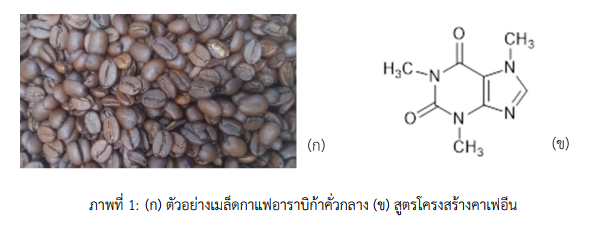Determination of Caffeine Content in Arabica Coffee Beans Using High-Performance Liquid Chromatography
Keywords:
Coffee, Caffeine, Ultrasound-assisted extraction, High-Performance Liquid Chromatography, Diode-Array DetectorAbstract
Caffeine is an alkaloid organic compound. It has a stimulating effect on the central nervous system, often found in coffee beans. This research aimed to determine the caffeine content in Caffea Arabica L. beans using high-performance liquid chromatography with a diode array detector in the wavelength of 274 nm. The amount of caffeine in coffee beans was extracted by ultrasound-assisted extraction with methanol-water. The optimum separation was performed on the C8 column with isocratic elution consisting of methanol and water (30:70, v/v) as mobile phase at a 1 mL/min flow rate. The injection volume was 5 µl. In the evaluation of method validation, it was found that there was a linear relationship in the concentration range of 0.50 – 10.00 µg/mL (R2 = 0.9999). The limit of detection and quantification were 0.13 and 0.43 µg/mL, respectively. The relative standard deviation percentage was 1.02-0.21%, while the percent recovery varied between 96.00 and 98.50%. The method was applied to determine the caffeine content in samples of roasted Arabica coffee beans grown in various locations. It was found that the caffeine content in the samples was in the concentration range of 1.10–1.49% w/w.
References
Piotr Konieczka P., Aliaño-González M.J., Ferreiro-González M., Barbero G.F., Palma M. (2020). Characterization of arabica and robusta coffees by ion mobility sum spectrum. Sensors. 20(11), 3123 (1-15).
พัชนี สุวรรณวิศลกิจ. (2542). กาแฟสกัดคาเฟอีน. วารสารเกษตร. 15(1), 1–10.
Wanyika H., Gatebe E., Gitu L., Ngumba E., Maritim C. (2010). Determination of caffeine content of tea and instant coffee brands found in the Kenyan market. African Journal of Food Science. 4(6), 353–358.
Pokhrel P., Shrestha S., Rijal S.K., Rai K.P. (2016). A simple HPLC Method for the Determination of Caffeine Content in Tea and Coffee. Journal of Food Science and Technology Nepal. 9, 74–78.
สุพัตรา รักษาพรต, สุนิษา สุวรรณเจริญ, เรืองวิทย์ สว่างแก้ว, เกศสุดา สามารถ, จิตรลดา บุญเฒ่า. (2561) การผลิตสบู่คาเฟอีนเพื่อเพิ่มมูลค่ากากกาแฟเหลือทิ้ง. วารสารวิทยาศาสตร์ มข. 46(1), 38–43.
Shehata A.B., Rizk M.S., Rend E.A. (2016). Certification of caffeine reference material purity by ultraviolet/visible spectrophotometry and high-performance liquid chromatography with diode-array detection as two independent analytical methods. Journal of Food Drug Anallysis. 24(4), 703–715.
Bohrer D., Lapinski J., De Carvalho L.N., Do Nascimento P.T., Viana C. (2019) Development and Validation of an HPLC-DAD Method to Quantify Caffeine in Time-release Dosage Forms. Indian Journal of Pharmaceutical Sciences. 81(4), 626-632.
Lopez-Sanchez R. del C., Lara-Diaz V.J., Aranda-Gutierrez A., Martinez-Cardona J.A., Hernandez J.A. (2018). HPLC Method for Quantification of Caffeine and Its Three Major Metabolites in Human Plasma Using Fetal Bovine Serum Matrix to Evaluate Prenatal Drug Exposure. Journal of Analytical Methods in Chemistry. 2018, 1-11.
Naser L.R., Sameh A., Muzaffar I., Omar A.R., Ahmed M.A. (2018). Comparative evaluation of caffeine content in Arabian coffee with other caffeine beverages. African Journal of Pharmacy and Pharmacology. 12(2), 19–26.
Craig A.P., Fields C., Liang N., Kitts D., Erickson A. (2016). Performance review of a fast HPLC-UV method for the quantification of chlorogenic acids in green coffee bean extracts. Talanta. 154, 481-485.
Aly A.A., Kassem M.A., Amin A.S. (2013). Determination of caffeine in roasted and irradiated coffee beans with gamma rays by high performance liquid chromatography. Food Science and Quality Management. 22, 28-34.
Lima A.R., Pereira R.G., Abrahão S.A., Zangeronimo M.G., Paula F.B., Duarte S.M. (2013). Effect of decaffeination of green and roasted coffees on the in vivoantioxidant activity and prevention of liver injury in rats. Revista Brasileira de Farmacognosia. 23(3), 506-512.
Karima B., Amira-Guebailia H., Boulmokh Y., Houache O. (2014). HPLC coupled to UV–vis detection for quantitative determination of phenolic compounds and caffeine in different brands of coffee in the Algerian market. Journal of the Taiwan Institute of Chemical Engineers. 45, 1314–1320.
ทิพวรรณ นิ่งน้อย. (2549). แนวปฏิบัติการทดสอบความถูกต้องของวิธีวิเคราะห์ทางเคมีโดยห้องปฏิบัติการเดียว. นนทบุรี: กรมวิทยาศาสตร์การแพทย์ กระทรวงสาธารณสุข.
Chandran S., Singh R. (2007). Comparison of various international guidelines for analytical method validation. Die Pharmazie . 62, 4–14.
Jitkaew N., Sinaviwat S. (2022). Method validation for determination of sucralose in beverage by high performance liquid chromatography. Bulletin of Applied Sciences. 11(11), 35–44.
Tanaviyutpakdee P., Karnpanit W., Alongkornchotikul R. (2022). The Importance of Method Validation for Risk Assessment of Exposure to Chemicals in Foods. Thai Journal of Toxicology 37(1), 27–44.
Rostagno M.A., Manchón N., D’Arrigo M., Guillamón E., Villares A., García-Lafuente A., et al. (2011). Fast and simultaneous determination of phenolic compounds and caffeine in teas, mate, instant coffee, soft drink and energetic drink by high-performance liquid chromatography using a fused-core column. Analytica Chimica Acta. 685, 204–211.

Downloads
Published
Issue
Section
License
Copyright (c) 2024 Journal of KPRU Science Mathematics and Technology

This work is licensed under a Creative Commons Attribution-NoDerivatives 4.0 International License.
บทความที่ได้รับการตีพิมพ์เป็นลิขสิทธิ์ของวารสาร มรภ.กพ. วิทยาศาสตร์ คณิตศาสตร์ และเทคโนโลยี
ข้อคิดเห็นใดๆ ที่ปรากฎในวารสารเป็นวรรณกรรมของผู้เขียนโดยเฉพาะ ซึ่งมหาวิทยาลัยราชภัฏกำแพงเพชรและบรรณาธิการไม่จำเป็นต้องเห็นด้วย



